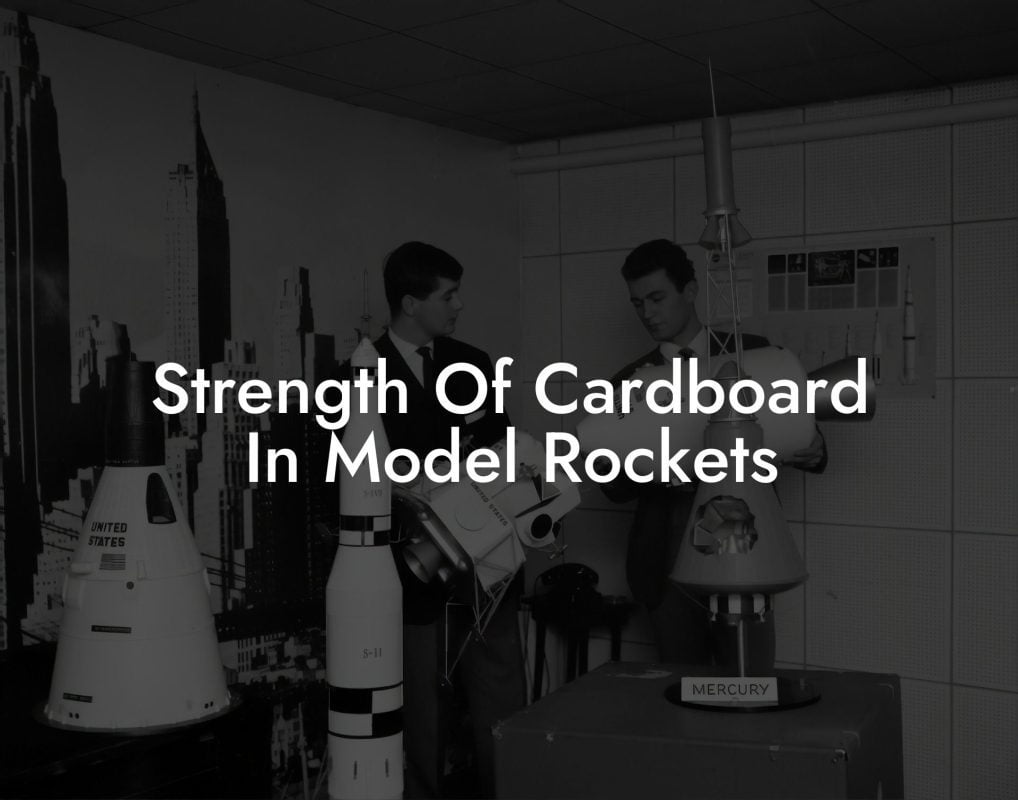Imagine soaring to new heights, defying gravity, and exploring the thrill of space travel without leaving the ground. Welcome to the world of model rockets, where creativity meets innovation and the sky's the limit! Whether you're a seasoned enthusiast or just starting out, this comprehensive guide will blast off your journey into the fascinating realm of model rockets, complete with expert tips, launch pad essentials, and a galaxy of inspiration.
Quick Links to Useful Sections
- What Are Model Rockets?
- The Anatomy of a model rocket
- Launch Pad Essentials
- Designing and Building Your Dream Rocket
- Choose Your Materials Wisely
- Optimize Your Design
- Pay Attention to Detail
- Launch and Recovery: The Thrill of Flight
- Pre-Launch Checklist
- Launch and Tracking
- Recovery and Analysis
- Resources and community Support: Your Next Steps
- Frequently Asked Questions: Model Rocketry 101
What Are Model Rockets?
Model rockets are scale models of real rockets, designed to mimic the look, feel, and functionality of their full-sized counterparts. They're typically made of lightweight materials, such as balsa wood, plastic, or fiberglass, and powered by small motors that propel them into the air. From simple, beginner-friendly kits to intricate, high-performance models, there's a model rocket out there for everyone.
The magic of model rockets lies in their ability to capture the essence of space exploration, while providing an accessible, affordable, and fun way to experience the thrill of rocketry. Whether you're interested in science, technology, engineering, and mathematics (STEM) education, or simply looking for a unique hobby, model rockets offer an unparalleled adventure.
The Anatomy of a model rocket
A typical model rocket consists of several key components:
- Nose Cone: The pointed tip of the rocket, designed to reduce air resistance and protect the payload.
- Body Tube: The main structure of the rocket, housing the motor, recovery system, and payload.
- Fins: Stabilizers that provide directional control and prevent the rocket from spinning out of control.
- Motor: The power source that propels the rocket into the air, available in various sizes and types.
- Recovery System: A parachute or streamer that deploys to slow the rocket's descent and ensure a safe landing.
- Payload: The cargo or instrument carried by the rocket, which can include cameras, sensors, or even small animals.
Understanding the different parts of a model rocket is crucial for designing, building, and launching a successful flight.
Looking For The Best Model Rocket Kits? You'll Love These:
Launch Pad Essentials
Before you can blast off into the skies, you'll need a solid launch pad setup. Here are the must-haves:
- Launch Pad: A sturdy, portable platform that provides a stable base for your rocket.
- Launch Rod: A metal or plastic rod that guides the rocket during launch, ensuring a smooth, vertical ascent.
- Ignition System: A device that ignites the motor, such as a battery-powered launch controller or a simple ignition switch.
- Safety Gear: Essential items like safety glasses, a launch rod holder, and a first-aid kit to ensure a safe and enjoyable experience.
A well-equipped launch pad is crucial for a successful and enjoyable model rocketry experience.
Designing and Building Your Dream Rocket
The art of designing and building a model rocket is a thrilling adventure in itself. Here are some expert tips to get you started:
Choose Your Materials Wisely
Select materials that balance weight, strength, and durability, such as balsa wood, plastic, or fiberglass.
Optimize Your Design
Consider factors like aerodynamics, stability, and payload capacity to create a rocket that flies smoothly and efficiently.
Pay Attention to Detail
Ensure a precise fit between components, and apply a coat of paint or finish to protect your rocket from the elements.
With patience, creativity, and practice, you can craft a model rocket that's both functional and visually stunning.
Launch and Recovery: The Thrill of Flight
The moment of truth has arrived – it's time to launch your rocket! Here's what you need to know:
Pre-Launch Checklist
Ensure your rocket is properly assembled, the motor is securely attached, and the recovery system is functioning correctly.
Launch and Tracking
Launch your rocket, track its flight, and use a altimeter or GPS to monitor its performance.
Recovery and Analysis
Retrieve your rocket, inspect its condition, and analyze the flight data to refine your design and improve future launches.
The rush of launching a model rocket is an exhilarating experience that will leave you wanting more.
Resources and community Support: Your Next Steps
As you embark on your model rocketry journey, remember that you're not alone. Here are some valuable resources to help you along the way:
- Online Forums and Communities: Join online forums, social media groups, and specialized clubs to connect with fellow enthusiasts, share knowledge, and learn from their experiences.
- Tutorials and Guides: Explore online tutorials, YouTube channels, and instructional books that provide step-by-step guidance on designing, building, and launching model rockets.
- Local Clubs and Meetups: Attend local model rocketry clubs, meetups, and events to network with other enthusiasts, participate in group launches, and gain hands-on experience.
By tapping into these resources, you'll be well on your way to becoming a skilled model rocketeer, surrounded by like-minded individuals who share your passion.
Frequently Asked Questions: Model Rocketry 101
Got questions about model rockets? We've got answers! Here are some frequently asked questions to get you started:
1. What's the best type of model rocket for beginners?
Look for starter kits that include pre-cut parts, simple designs, and easy-to-follow instructions.
2. How high can model rockets fly?
Depending on the motor and design, model rockets can reach altitudes ranging from a few hundred feet to several thousand feet.
3. Are model rockets safe?
Yes, when handled properly and following safety guidelines, model rockets are a safe and enjoyable hobby.
4. Can I customize my model rocket?
Absolutely! Model rocketry is all about creativity and experimentation – feel free to modify designs, try new materials, and push the boundaries of innovation.
Looking For The Best Model Rocket Kits? You'll Love These:
Useful Interruption: Dive deeper into the world of Model Rockets with our most popular sections. If there is anything you think is missing or anything you would love for us to write about, just give us a shout.
- Getting Started & Basics With Model Rockets
- Model Rocket Design, Build & Customization
- Model Rocket Propulsion & Engine Technology
- Model Rocket Launch Techniques & Recovery
- Model Rocket Advanced Rocketry & Innovations
- Model Rocket DIY and Customization
- Model Rocket Equipment Reviews & Digital Tools
- Community, Competitions & Education
- Model Rocket Troubleshooting & FAQs
- Model Rocket Bonus/Seasonal & Niche Topics
A group of model rocket enthusiasts gathered at a field for their weekly launch event. Among them was Dave, a seasoned builder known for pushing the limits of hobby rocketry. This time, he had outdone himself.
“Ladies and gentlemen,” Dave announced, dramatically pulling a cloth off his latest creation, “I present to you: The Kraken!”
The crowd gasped. This wasn’t just a model rocket—it was a monster. The thing stood 8 feet tall, had six clustered engines, and was covered in enough duct tape to qualify as a classified aerospace project.
“Dave,” muttered Steve, the cautious safety officer, “Have you, uh… done the math on this?”
“Math?” Dave scoffed. “I built it in my garage at 3 a.m. with parts from eBay. This is an art piece, Steve.”
The countdown began.
5…
4…
3…
2…
1…
The engines ignited with a BOOM, and The Kraken shot up… kind of. It immediately did a violent barrel roll, narrowly missing the spectators before skyrocketing at an angle that could only be described as “legally questionable.”
The crowd collectively ducked as The Kraken flew straight over the adjacent cornfield, where Old Man Jenkins, the grumpiest farmer in town, was minding his business.
KABOOM!
The rocket disappeared behind the barn. A moment later, a flaming piece of Estes igniter wire landed at Steve’s feet. The silence was deafening.
And then—an unmistakable sound echoed across the field.
Jenkins’ shotgun being cocked.
“DAVE!!!” Steve shouted. “RUN.”
And that was the day Dave invented the first-ever biologically powered rocket booster: pure adrenaline.
To this day, nobody knows where The Kraken landed, but legend has it, it still haunts the skies, terrifying unsuspecting drones and low-flying birds.















